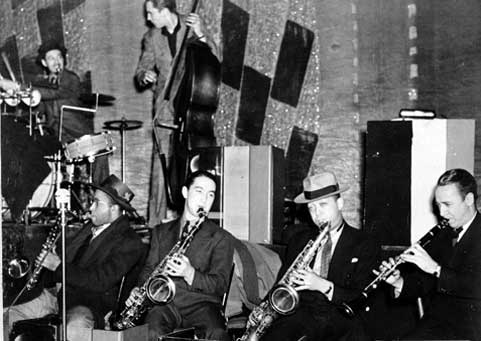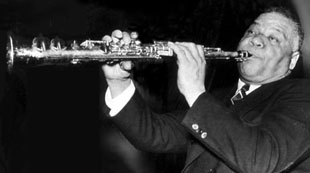The clarinet and the saxophone are first cousins—both produce their sound using a single reed, and so are classed as "single-reed woodwinds."
Before 1920 early jazz bands took their instrumentation from military bands, where the clarinet was the important high voice. The saxophone was rarely heard, but most 'first generation' New Orleans jazz clarinetists—including Lorenzo Tio, Barney Bigard, and Johnny Dodds—could "double" on sax and sometimes used it for a vocal effect.
Jazz fans of the 1920s heard the beginning of true saxophone virtuosity in recordings by Frank Trumbauer on C melody sax and Adrian Rollini on the Bb bass sax. Both instruments are all but forgotten today.
Also in the 20s Sidney Bechet became the earliest master of the Bb soprano sax, an instrument that did not receive much subsequent attention until John Coltrane sparked a revival with his landmark recording of "My Favorite Things" in 1960.
One of the first popular dance bands to use more than one sax was the Fletcher Henderson Orchestra in 1925. The stunning, cohesive precision of the sax men in this band would give rise to the driving 'sax section' sound of the Swing Era ten years later.
By the 1930s the saxophone sound had become so popular in jazz that the clarinet was almost totally edged out of the front line in most jazz bands. It was the tenor sax that took over as the dominant reed solo voice in jazz with the rise of great swinging innovators such as Coleman Hawkins and Lester Young.

Ray Bauduc, Herschel Evans, Bob Haggart, Eddie Miller, Lester Young and Matty Matlock, Howard Theater Washington DC, 1941. © William Gottlieb
Even New Orleans-oriented "traditionalist" bands such as Bob Crosby's Bob Cats, Bud Freeman and Muggsy Spanier added a tenor sax to the front line in the 30s. While many fans prefer the purity and simplicity of the traditional three-horn front line—trumpet, trombone and clarinet—the addition of the saxophone voice gives the ensemble sound a new dimension, depth and color.
This week on Riverwalk Jazz The Jim Cullum Jazz Band joins forces with sax man Kim Cusack and others to explore the music of early jazz saxophone masters. Our own Ron Hockett shows off his saxophone chops while his usual clarinet duties are covered by Allan Vaché and Evan Christopher. And bass saxophonist Vince Giordano recalls Adrian Rollini's pivotal role in the Jazz Age sound of Bix Beiderbecke's classic recordings. The late clarinet legend Kenny Davern and late former band member Brian Ogilvie are heard in encore performances from the archive.
Photo credit for Home Page: Lester Young. Image courtesy williamhorberg.typepad.
Text based on Riverwalk Jazz script by Margaret Moos Pick ©2010



